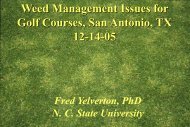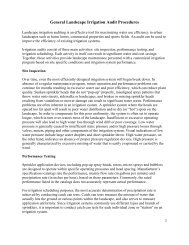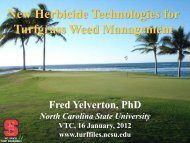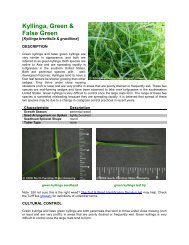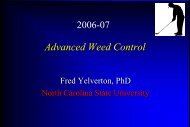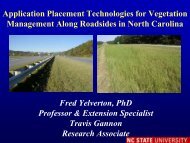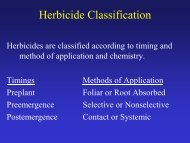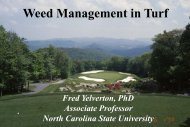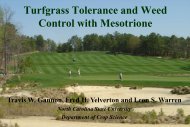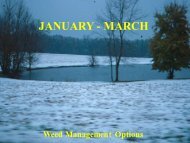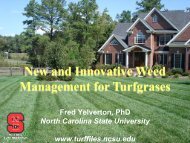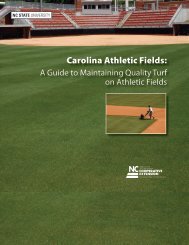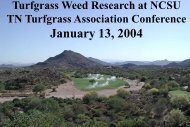Weed Management Strategies for Newly/Spring Seeded ... - TurfFiles
Weed Management Strategies for Newly/Spring Seeded ... - TurfFiles
Weed Management Strategies for Newly/Spring Seeded ... - TurfFiles
You also want an ePaper? Increase the reach of your titles
YUMPU automatically turns print PDFs into web optimized ePapers that Google loves.
<strong>Weed</strong> <strong>Management</strong> <strong>Strategies</strong> <strong>for</strong><strong>Newly</strong>/<strong>Spring</strong> <strong>Seeded</strong> LawnsTravis Gannon
<strong>TurfFiles</strong>www.<strong>TurfFiles</strong>.ncsu.eduFind thispresentation andmore onlineSign-up <strong>for</strong>Turf ALERTSLearn aboutturfgrass pests:•<strong>Weed</strong>s•Insects•DiseasesIdentify your turf orweed species usingDecision Aids
<strong>TurfFiles</strong>www.<strong>TurfFiles</strong>.ncsu.edu
Anybody recognize these headlines??WRAL 9/13/2007State Continues to Dry Up
Given droughty conditions of last summer and fall,lawns remain in less than optimum condition.what do you do with all of the seed you boughtand couldn’t use?
You can dump the seed out and at least use the bag…
or you can spring-seed…
Things to consider when spring-seeding Tallfescue• First and <strong>for</strong>emost– It’s a temporary fix! Subsequent fall seedingwill still be necessary <strong>for</strong> a permanent stand.• Timing is key (Seed, fertilizer, moisture)• <strong>Weed</strong> control practices must changesignificantly• Preventive and/or curative disease controlwill likely be necessary during earlysummer
Ideally, Cool-season turf should be seeded during the fall.Why is this?Not HereHereHere
Tall Fescue Germination• Optimal air temperatures <strong>for</strong> tall fescue germinationis 68 to 77 °F, with little germination below 60°.• Very little germination with soil temperature below50°.• Avg Max Soil - Air Temp, 2004-05– Feb. 44 - 52– Mar. 52 - 62– Apr. 60 - 72– May 68 - 80– June 78 - 86– Sep. 78 - 80– Oct. 68 - 70– Nov. 56 - 64– Dec. 44 - 52mid Feb – late March
2008 Tall fescue <strong>Spring</strong>-Seeding StudySandhills Research Station• Seeding dates every 2 weeksfrom Feb 15 th to April 15th• Broadcast v/s slit-seeding• Irrigation (0.5”/week)v/s no irrigation
Soil Preparation• Aeration or slit-seeding is necessary to provide soil toseed contact• Perfect time to apply– Lime (pH adjustment)– Starter fert (high P)
<strong>Spring</strong> <strong>Seeded</strong> Tall Fescue in NC‣Not typically recommended dueto inability to survive summerwhen seeded in spring.
<strong>Spring</strong> <strong>Seeded</strong> Tall Fescue in NC‣Tolerance to herbicides can be asignificant problem.‣Typical PRE herbicide programmust be altered.
<strong>Spring</strong> Preemergence HerbicideApplications to Lawns that are notWell-Established Established Lawns‣Certain labels caution against it.‣Safety depends on root growthand establishment.
% Tall Fescue Injury<strong>Spring</strong> Applied Herbicides to FallEstablished Fescues70646050403020100423194601510493024Barricade 0.75 lb/aDimension 0.5 lb/aTeam 3 lb/apendimethalin 3 lb/aNontreatedOct. 2 Oct. 16 Oct. 30Tall Fescue Seeding DateHerbicides applied March 11; ratings 4-18
How Much Growth Should Tall FescueHave Be<strong>for</strong>e a PRE Herbicide is AppliedProdiamine - tilleredPendimethalin – extensively tilleredDimension – extensively tillered
What does “extensively tillered” mean?Not tilleredTillered
What does “extensively tillered” mean?
<strong>Weed</strong> Control With Preemergence HerbicidesHerbicides do not prevent weeds from germinating,they kill weeds as they grow through the herbicide
DNAherbicidescan injurestoloniferousturf speciesthat are notwellestablished
<strong>Spring</strong> Preemergence HerbicideApplications to Lawns - Precautions‣Barricade 65 WG: Do not applyto overseeded turf <strong>for</strong> 60 daysafter seeding or until after thesecond mowing.
<strong>Spring</strong> Preemergence HerbicideApplications to Lawns - Precautions‣pendimethalin: Use only on wellestablished turf with a dense anduni<strong>for</strong>m stand. Wait until the turfhas been mowed at least fourtimes.
Dinitroanalines and Dimension‣Behavior in Plants: Absorbed byroots and emerging shoots andinhibit mitosis which prevents celldivision and elongation. Sensitivespecies fail to emerge.
Herbicides <strong>for</strong> Use on<strong>Spring</strong> <strong>Seeded</strong> Lawns‣Tupersan‣Dimension‣Acclaim Extra‣Drive‣Tenacity‣Prodiamine‣Pendimethalin
Scenario 1‣Use Tupersan at seeding orshortly thereafter. Providesabout 30-45 days control.‣Use PRE herbicide when fescueis tolerant.
Scenario 2‣Use nothing at seeding.‣When fescue is tolerant, utilize amixture of POST herbicide andPRE herbicide. Or use a POSTherbicide followed by a PREherbicide when fescue is tolerant.
Scenario 3‣Use nothing at seeding.‣Use quinclorac (Drive) as anearly POST at 0.75 lbs ai/a + 1.5pts/a of a methylated seed oil.‣Use PRE herbicide when fescueis tolerant.
Scenario 4‣Use nothing at seeding.‣Use Acclaim Extra at 9 to 13 oz/aas an early POST (crabgrassmust be pre-tiller).‣Use PRE herbicide when fescueis tolerant.
Scenario 5‣Use nothing at seeding.‣Use Dimension when fescue istolerant (extensively tillered).Dimension will control crabgrassup to 3-4 leaf stage when appliedat 0.5 lbs ai/a.
‣Use Tenacity at seeding.Provides about 30 days PREcontrol.Scenario 6(not a current option)‣Use PRE herbicide when fescueis tolerant.
Scenario 7(not a current option)‣Use nothing at seeding.‣Use Tenacity POST at 8 oz/a + anonionic surfactant at 1 pt/50 galof water. Repeat in 2-3 weeks.‣Use PRE herbicide when fescueis tolerant.
Treat thissizeNot this
Preemergence herbicidesHow dotheycompare inestablished turf?
% ControlSmooth Crabgrass Control in Tall Fescue100LSD=30 (P=0.05)80604020Barricade 65WGBarricade 4FDimension 1ECDim Ultra 40WPPendulum 60DFPend. Aqua Cap 3.8CSNontreated0Single ApplicationSplit ApplicationEvaluations collected 09-06-05, 186 DAIT. Treatments applied: Mar 04 and April 28
% ControlSmooth Crabgrass Control in Bermudagrass100LSD=16 (P=0.05)80604020Barricade 65WGBarricade 4FDimension 1ECDim Ultra 40WPPendulum 60DFPend. Aqua Cap 3.8CSNontreated0Single ApplicationSplit ApplicationEvaluations collected 09-06-05, 191 DAIT. Treatments applied: Mar 04 and April 28
Why?Not HereHereHere
% ControlPRE Control of Crabgrass100806050969086 85Pendimeth DG 3 lb aiPendimeth G 3 lb aiBarricade WG .75 lb aiRonstar WP 3 lb ai40Ronstar G 3 lb ai200Ratings taken Sept 19. Rates are per acre applied3-1. Thorndale CC, 2002
Liquid v/s Granular productsWhat’s the difference?
<strong>Weed</strong>s in TurfLiquid v/s granular applications of pre-emergent herbicidesLiquid• Pros– More uni<strong>for</strong>m application– Not bound to N rate to get enough herbicide on the ground• Cons– Must have properly calibrated sprayer– MUST BE WATERED IN WITHIN 2 TO 3 DAYS AFTER APPLICATION
<strong>Weed</strong>s in TurfLiquid v/s granular applications of pre-emergent herbicidesGranular• Pros– May be applied with a rotary spreader– HAVE LITTLE FLEXIBILITY FOR WATERING IN• Cons– Need to apply in at least two different directions to achieve uni<strong>for</strong>mcoverage– Bound to N rate to get enough herbicide on the ground
Size of Particle is Critical
Uni<strong>for</strong>mity of Particle Size
Particles Have A Sphere of Influence
Particles Have A Sphere of Influence
Crabgrass Control with DimensionImpregnated on Fertilizer# particles/g 0.25 lbs ai/a 0.5 lbs ai/a23 27 6658 48 75165 56 75465 59 841310 68 82Kelly and Coats, MSU (unpublished data)
PRE Smooth Crabgrass ControlWith BarricadeTreatment Lbs AI/A % ControlNontreated -- 0Barricade 65 WG 0.75 98Barricade 0.5 G 0.75 81Barricade 0.29 G 0.75 91LSD 0.05 9.3Experimental Barricade FormulationsHidden Valley GC, 1996. Applied March 4, evaluated Sept. 26
Effect of Mowing Height on LargeCrabgrass Incidence• 3.5lbs Crabgrass/1000ft 2 on March 7, 2007• Mowing Heights initiated when soiltemperatures reached 55°F – Mowed every4 days thereafter
Effect of Mowing Height on LargeCrabgrass Incidence• Bermudagrass mowing heights– 0.5”, 1”, 1.5”, 2.0”• Tall fescue mowing heights– 1”, 2”, 3”, 4”
Effect of Tall Fescue Mowing Height onCrabgrass Incidence% Crabgrass80706079a74a5040302031b1001.0" 2.0" 3.0" 4.0"Mowing Height0cData Collected: 09-13-07, LSD (P=0.05), Sandhills Research Station, Sodman 90/10 (mixture w/bluegrass)
1” 2”3” 4”
Nutrient <strong>Management</strong> ProgramsFertilization ratesHow much N do you apply in one year?• Low End (2 to 3 lbs N per year)– February, September, and November– 1 lb N per 1000 ft 2 per application• High End (5 to 6 lbs N per year)– Every 4 to 6 weeks in spring and fall– February, early to mid-March, early April– September, mid October, late November
Nutrient <strong>Management</strong> ProgramsFertilization ratesHow late can you apply N in the spring?• Be careful with heavy applications of N after midto late April.• Increased N rates during summer can increasebrown patch incidence.• Iron is a good substitute <strong>for</strong> N <strong>for</strong> late springearlysummer applications.– Still get the greening response without the surge ingrowth
Herbicides <strong>for</strong> Use on<strong>Spring</strong> <strong>Seeded</strong> Lawns‣ NOTE: Tenacity is a new herbicide that justreceived EPA registration. To date, Tenacity isregistered <strong>for</strong> golf courses and sod farms anddoes not have a registration <strong>for</strong> use in lawns. Aregistration <strong>for</strong> lawns in anticipated at somepoint in the future. Be<strong>for</strong>e Tenacity is used inlawns, check to see if the registration in lawnshas been granted. The following in<strong>for</strong>mation onTenacity is provided based on research trialsconducted in NC.
Tenacity• A new chemical class – Triketones• Active ingredient – 40% Mesotrione• Formulation – 4SC• Signal word – Caution• For Use by Professional Applicators• Do not enter treated areas until spray has dried
Tenacity 4SC Registration Timing• EPA granted registration December 14, 2007<strong>for</strong> golf and sod• Anticipate residential and commercial labels in early2008• State Registrations– 1-2 months after federal registration withnormal state review delays• NY, FL, MA, etc….A CA submission will bedelayed.• Available 2008
Main Point to Remember AboutTenacityAlways requires at least twoapplications (splits)
Tenacity Use Rates• 5 to 8oz/A = Kentucky bluegrass, tall fescue,centipedegrass• 5oz/A = Perennial ryegrass, fine fescue• Repeat applications at 2-3 weeks when appliedalone• Maximum of 16oz/A per year or crop(whichever is shorter)• Apply in 30-40 gal/A water and add a NIS <strong>for</strong>post-emergence applications
• Absorbed by plants throughroots, shoots and leaves.Tenacity• Distributed throughout theplant by both xylem andphloem translocation within24-hrs (systemic)• Foliar symptoms(bleaching) in 5-7-daysCrabgrass• Tolerant turfgrass speciesquickly metabolize Tenacityand are unaffected.
Tenacity Applications• Labeled on Kentucky bluegrass, tall fescue,centipedegrass, perennial ryegrass* and finefescue*• Apply to established turf with no seedingrestrictions• Apply prior to or at seeding to labeled species(except fine fescue).*Reduced rates on these species or as >50% of turf composition. No more than 20% FFin blend <strong>for</strong> use at seeding.
34 Dicot and 11 Monocot Species onTenacity Label Including:• Crabgrass spp. • Speedwell• Goosegrass• Lawn burweed• Nimblewill• Dandelion spp.• Bentgrass• Canada thistle• Oxalis• Yellow nutsedge• Buckhorn plantain • Yellow foxtail• Clover spp.• Ground IvyThis list will expand as research and commercial use find new species.
Turfgrass Tolerance to TenacityTall FescueKY BluegrassPerennial RyegrassCentipedegrassSt Augustinegrass
Turfgrasses Not Tolerant to TenacityBentgrassZoysiagrassBermudagrass (moderate tolerance)
Smooth and large Crabgrass (Digitaria spp.)



